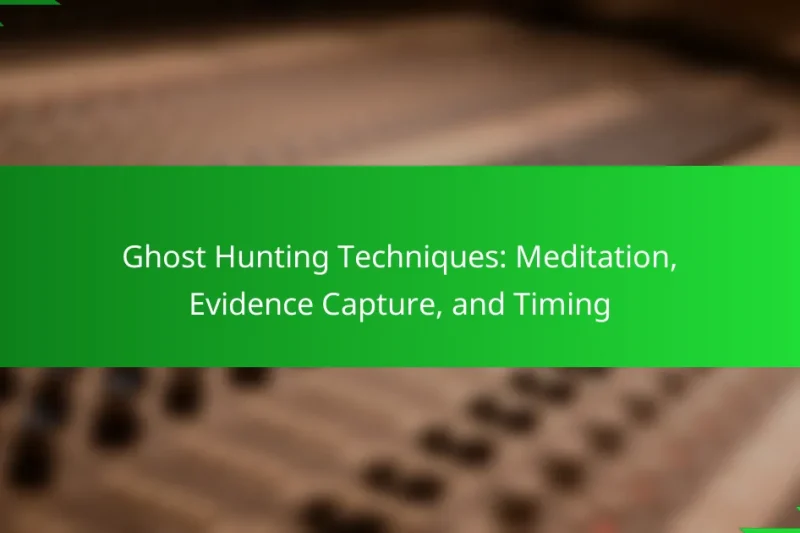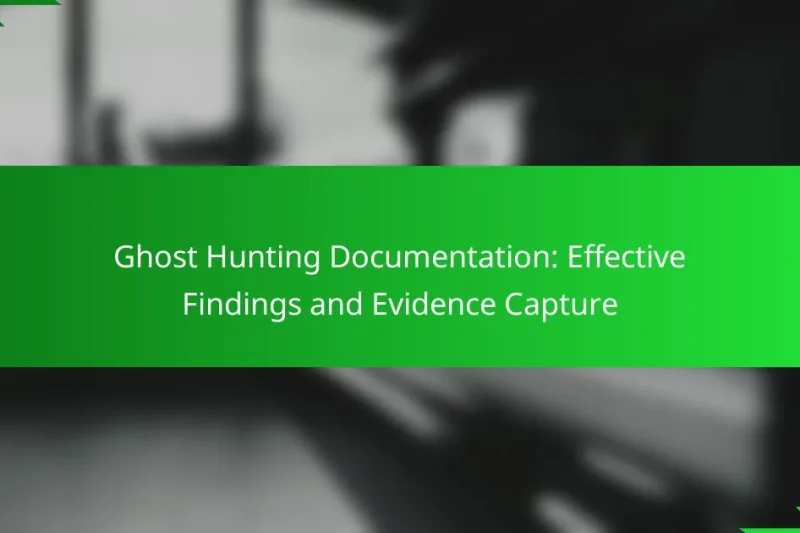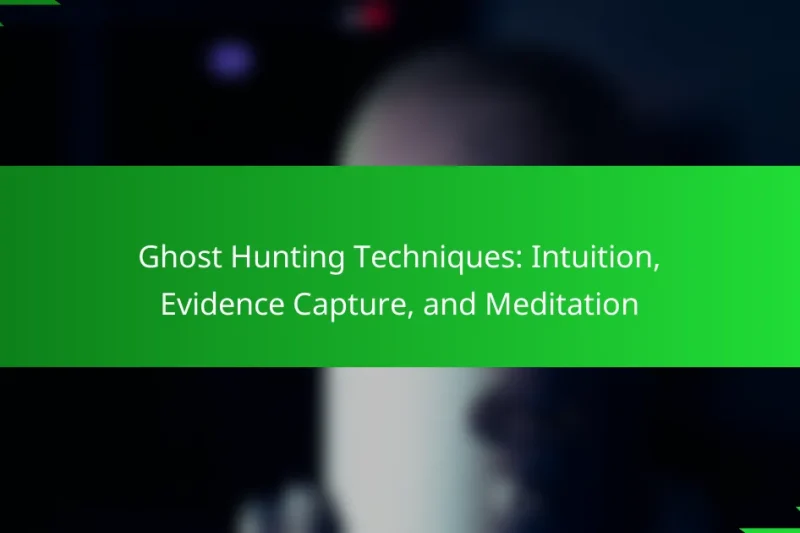Ghost hunting combines various techniques to enhance the experience and increase the chances of encountering the … Ghost Hunting Techniques: Meditation, Evidence Capture, and TimingRead more
Ghost Hunting Equipment: Techniques and Strategies
Ghost hunting is an intriguing pursuit that requires the right equipment and techniques to effectively investigate paranormal activity. Essential tools such as EMF meters, digital voice recorders, and night vision cameras play a crucial role in capturing evidence. By selecting appropriate gear based on your needs and employing effective strategies like EVP sessions and thermal imaging, you can enhance your ghost hunting experience and increase your chances of making contact with the unknown.
Ghost Hunting Techniques: Timing, Documentation, and Intuition
Ghost hunting combines various techniques to explore potential paranormal activity, with methods such as EVP sessions, … Ghost Hunting Techniques: Timing, Documentation, and IntuitionRead more
Ghost Hunting Documentation: Effective Findings and Evidence Capture
Ghost hunting documentation is essential for capturing credible evidence and enhancing the overall investigation experience. By … Ghost Hunting Documentation: Effective Findings and Evidence CaptureRead more
Ghost Hunting Techniques: Intuition, Evidence Capture, and Meditation
Ghost hunting combines various techniques to explore and document paranormal phenomena, including intuition, evidence capture, and … Ghost Hunting Techniques: Intuition, Evidence Capture, and MeditationRead more
What ghost hunting equipment is essential for beginners?
For beginners in ghost hunting, essential equipment includes EMF meters, digital voice recorders, infrared thermometers, flashlights, and night vision cameras. These tools help detect paranormal activity and capture evidence effectively.
EMF meters
EMF meters measure electromagnetic fields, which some believe can indicate the presence of spirits. These devices can detect fluctuations in electromagnetic energy, typically in the range of 0.1 to 20 milligauss.
When using an EMF meter, look for sudden spikes in readings that occur without any electrical sources nearby. Avoid common pitfalls like assuming all EMF readings indicate paranormal activity; many can stem from household appliances or wiring.
Digital voice recorders
Digital voice recorders capture audio during investigations, allowing you to listen for potential EVPs (Electronic Voice Phenomena) later. Choose a recorder with good sound quality and a decent battery life, ideally lasting several hours.
To maximize results, conduct sessions in quiet locations and ask open-ended questions. Review recordings carefully, as EVPs may be faint and require amplification for clarity.
Infrared thermometers
Infrared thermometers measure surface temperatures without direct contact, helping to identify cold spots that may suggest paranormal activity. These devices are typically accurate within a few degrees and can detect temperature variations in the range of -50°C to 500°C.
When using an infrared thermometer, take multiple readings in the same area to establish a baseline. Be cautious of environmental factors, such as drafts or heat sources, that could skew your results.
Flashlights
Flashlights are crucial for navigating dark environments during ghost hunts. Opt for LED flashlights, which offer longer battery life and brighter illumination compared to traditional bulbs.
Always carry extra batteries and consider using red filters to preserve night vision. Avoid shining lights directly at cameras, as this can wash out images and hinder evidence collection.
Night vision cameras
Night vision cameras allow you to capture video in low-light conditions, making them essential for documenting potential paranormal activity. Look for models with infrared capabilities to enhance visibility in complete darkness.
When setting up night vision cameras, position them strategically to cover areas of interest. Ensure they have adequate battery life and storage capacity to record for extended periods, as ghost hunts can last several hours.
How to choose the right ghost hunting gear?
Choosing the right ghost hunting gear involves assessing your specific needs, budget, and the types of investigations you plan to conduct. Prioritize equipment that enhances your ability to gather evidence while remaining within your financial limits.
Consider your budget
Your budget is a crucial factor when selecting ghost hunting equipment. Prices can range from affordable tools like EMF meters and digital voice recorders, typically costing between $20 to $100, to high-end thermal imaging cameras that can exceed $1,000.
Establish a budget that allows for essential gear while leaving room for upgrades as you gain experience. Avoid overspending on unnecessary features; focus on what will genuinely aid your investigations.
Evaluate equipment features
<pWhen evaluating ghost hunting gear, consider the specific features that will enhance your investigations. Look for equipment that offers sensitivity, ease of use, and durability. For example, a digital voice recorder should have good battery life and clear audio quality.
Compare features across different models to find the best fit for your needs. For instance, some EMF meters may offer visual and audio alerts, which can be beneficial during investigations in low-light conditions.
Research brand reliability
Brand reliability is essential when choosing ghost hunting equipment. Research brands known for quality and durability, as well as those with positive user reviews. Established brands often provide better customer support and warranties.
Check online forums and ghost hunting communities for recommendations on reliable brands. This can help you avoid purchasing low-quality equipment that may fail during critical moments of your investigation.
What techniques enhance ghost hunting effectiveness?
Effective ghost hunting techniques include using electronic voice phenomena (EVP) sessions, spirit box sessions, and thermal imaging. These methods help gather evidence and improve the chances of encountering paranormal activity.
Using EVP sessions
EVP sessions involve recording audio in locations believed to be haunted, with the aim of capturing voices or sounds that are not audible during the recording. To conduct an EVP session, use a digital recorder and ask open-ended questions, allowing pauses for potential responses.
When reviewing recordings, listen for unexplained sounds or voices that may indicate a spirit’s presence. It’s helpful to use headphones to catch subtle audio details. Remember to conduct sessions in quiet environments to minimize background noise interference.
Conducting spirit box sessions
Spirit box sessions utilize devices that scan radio frequencies to create white noise, which spirits may manipulate to communicate. To perform a session, set the spirit box to sweep frequencies quickly and ask clear questions, pausing to listen for responses.
Be cautious of the potential for radio interference, as some responses may be coincidental. It’s advisable to document any relevant findings and repeat questions for clarity. Conducting sessions in locations with a history of paranormal activity can increase the likelihood of meaningful interactions.
Implementing thermal imaging
Thermal imaging cameras detect heat signatures, allowing ghost hunters to identify temperature variations that may indicate the presence of spirits. When using thermal imaging, scan areas for cold spots or unusual heat patterns, as these can suggest paranormal activity.
Investing in a quality thermal camera is essential, as lower-end models may not provide accurate readings. Be aware that environmental factors, such as drafts or electrical equipment, can affect temperature readings. Always cross-reference thermal findings with other evidence to build a comprehensive understanding of the location’s activity.
How to conduct a ghost hunt in haunted locations?
To conduct a ghost hunt in haunted locations, start by selecting a site known for paranormal activity and prepare thoroughly. Understanding the environment and having the right tools will enhance your chances of experiencing unexplained phenomena.
Research the location’s history
Investigating the history of a haunted location is crucial. Look for past events, tragedies, or notable figures associated with the site, as these can provide context for potential hauntings. Local libraries, historical societies, and online archives are excellent resources for gathering this information.
Understanding the background can also help you identify specific areas within the location that may be more active. For instance, sites with a history of violence or loss often have stronger paranormal claims.
Plan your equipment setup
Having the right equipment is essential for a successful ghost hunt. Common tools include EMF meters, digital voice recorders, infrared cameras, and spirit boxes. Each device serves a unique purpose, such as detecting electromagnetic fields or capturing audio evidence.
Before the hunt, create a layout for where to place your equipment. Ensure that your devices are fully charged and have backup batteries. Consider using a checklist to confirm that you have all necessary items, which may include flashlights, extra batteries, and notebooks for recording observations.
Establish communication methods
Effective communication methods can enhance your ghost hunting experience. Decide in advance how you will interact with your team and document findings. Using walkie-talkies can facilitate communication in larger locations where shouting may not be practical.
Additionally, consider establishing a protocol for asking questions during the hunt. Use clear, open-ended inquiries to encourage responses. For example, instead of asking yes or no questions, try asking, “Can you tell us your name?” This approach may yield more informative answers.
What are the best practices for ghost hunting?
The best practices for ghost hunting focus on safety, respect, and thorough documentation. Following these guidelines can enhance your experience and increase the likelihood of meaningful encounters.
Maintain a respectful attitude
Approaching ghost hunting with a respectful attitude is crucial. Spirits are often believed to be sensitive to the emotions and intentions of the living, so maintaining a calm and courteous demeanor can foster a more positive environment.
Always remember to ask for permission before attempting to communicate with any spirits. This can be as simple as verbally acknowledging their presence and expressing your intentions clearly.
Document findings thoroughly
Thorough documentation of your findings is essential for analyzing experiences and sharing results with others. Use a combination of written notes, audio recordings, and photographs to capture your investigations.
Consider creating a standardized log that includes the date, time, location, equipment used, and any notable occurrences. This structured approach helps in identifying patterns and drawing conclusions from your ghost hunting experiences.
Collaborate with experienced hunters
Collaborating with experienced ghost hunters can significantly enhance your skills and knowledge. Learning from those who have been in the field for a while allows you to gain insights into effective techniques and equipment usage.
Join local ghost hunting groups or online forums to connect with seasoned hunters. Participating in group investigations can provide valuable hands-on experience and foster a supportive community for sharing tips and best practices.
What are common ghost hunting myths?
Many myths surround ghost hunting, often leading to misconceptions about the paranormal. Understanding these myths can help enthusiasts approach ghost hunting with a clearer perspective and realistic expectations.
Myth: Ghosts can be captured
The belief that ghosts can be physically captured is a common myth in ghost hunting. While various tools and devices are used to detect paranormal activity, none can physically contain or trap a ghost.
Ghost hunters often use equipment like EMF meters, spirit boxes, and infrared cameras to interact with spirits. However, these tools primarily serve to measure environmental changes or capture audio and visual anomalies, not to capture entities themselves.
It’s crucial for ghost hunters to maintain realistic expectations and focus on documenting experiences rather than attempting to capture ghosts. This approach fosters a more genuine exploration of the paranormal without the disappointment of unattainable goals.



